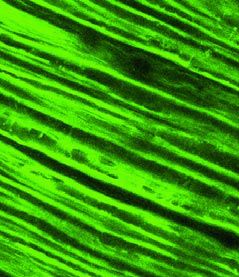
Physiology News Magazine
Cellular abnormalities in models of septic shock and in clinical disease:
One example of how rats and humans differ
Features
Cellular abnormalities in models of septic shock and in clinical disease:
One example of how rats and humans differ
Features
Michael Reade
Department of Human Anatomy and Genetics and Nuffield Department of Anaesthetics, University of Oxford
https://doi.org/10.36866/pn.49.12

Laboratory rats are wonderful animals, with a reputation unfairly tarnished by their ancestors’ carriage of the black death. Nonetheless, rodents are the subjects of most studies investigating the pathogenesis of septic shock, presumably because rats and mice are more easily studied than critically ill patients. Therapeutic advances based on this research may well promise new hope for critically ill rats. However there is increasing evidence that human sepsis may be a fundamentally different disease, suggesting conclusions based on animal models may not be applicable to humans.
Shock due to overwhelming infection – septic shock – should be relatively simple to treat. Most microorganisms that cause septic shock are initially sensitive to a large number of antibiotics, and vascular tone and cardiac output are usually easily manipulated with vasopressors and inotropes. Unfortunately, things aren’t that simple, which is why septic shock remains the leading cause of death in non-coronary intensive care with a mortality of around 50%, responsible for the deaths of around 250 000 people every year in the United States.

The fundamental problem in septic shock is not the direct effect of the microorganism, but the generalised inflammation induced in response. Multiple positive feedback loops stimulate the ever-increasing production of pro-inflammatory cytokines and effector molecules. The very large number of parallel pathways involved probably explains the disappointing results of clinical trials that block the actions of individual mediators. A better strategy might be to target the molecule hypothesised to form a common effector pathway for many of these cytokines: nitric oxide (NO).
Nitrate in the urine of febrile patients was first found to be elevated in 1818 (MacMicking et al 1997). However, it was only in 1987 that Ignarro and Palmer, Ferridge and Moncada demonstrated NO was the endothelial derived relaxing factor identified by Furchgott in 1980. Soon after, overproduction of NO was hypothesised to contribute to the hypotension of clinical sepsis. In addition to acting as a vasodilator, we now know NO can further stimulate inflammation, interfere with cellular oxygen utilisation, form cytotoxic free radicals, and act as a negative inotrope. The metabolites of NO are increased in the plasma of patients with sepsis, even when the confounding effect of renal failure is removed. However, the elevation of NO metabolites in human sepsis is nowhere near as marked as in rodents (Pastor & Suter 1998). Rodents have perhaps become more resistant to the effects of NO (as one might if one lived in a sewer), and humans have perhaps evolved mechanisms to limit NO production.
Different whole-body NO production in sepsis is the first warning that animals (or at least rodents) might not be the best models for human disease. A number of other differences are now described. Rat and mouse macrophages reliably produce large quantities of NO in response to a variety of stimuli, making them an easy (and popular) model in which to study the mechanisms of NO upregulation and its effects. That it is extremely difficult to make human macrophages behave in the same way (Schneemann et al 1993) is often conveniently ignored. Whilst it is known that circulating peripheral blood mononuclear cells from patients with septic shock do produce a small, but significantly increased amount of NO (Reade et al 2002b), it does not compare to the response of rodent cells under similar conditions.
Inflammatory cells are a convenient cell type to study, but NO produced in the vessel wall is much more likely to contribute to the shock which characterises sepsis. Endothelium seems to produce less NO in sepsis than in health, even in animal models (Zhou et al 1997). Animal vascular smooth muscle cells in culture or studied ex vivo can be stimulated to make NO, and increase their expression with inducible NO synthase mRNA. Human arterial smooth muscle cells in culture, stimulated with a very unphysiological cocktail of lipopolysaccharide and cytokines, can be made to behave in a similar manner (MacNaul & Hutchinson 1993). However there are very few studies of vascular smooth muscle from patients with clinical disease – and none that demonstrate with any statistical certainty any abnormality of the NO synthetic mechanism in this tissue.
Obtaining tissue from patients with septic shock is difficult. These patients are very ill, often requiring mechanical ventilation and sedation. Even those able to breathe spontaneously almost invariably have such disordered cognition that they are unable to give true informed consent, either for therapeutic procedures or for participation in research. Where possible in the UK, the assent of a close relative or guardian is sought, but this does not have the same legal status as the informed consent of the patient themselves. The conduct of research on such incompetent patients is very tightly regulated by institutional ethics committees, and what is allowed varies from place to place. For example, whilst in the United States even the collection of data on such patients (such as a review of the medical record) is the subject of some controversy (McRae & Weijer 2002), the European Society of Intensive Care Medicine recommends that the requirement to obtain consent or assent for research may be waived if a number of criteria (such as minimal risk involved for the patient, the subsequent provision of information about the study when this becomes possible, and prior approval of the protocol by the institutional review board) are met (Lemaire et al 1997).

Even leaving aside issues of consent, obtaining vascular tissue from septic patients is especially difficult. The need for ‘minimal risk’ to the patient essentially means studying tissue removed in the course of a therapeutic procedure. The mesenteric artery is a particularly good candidate, as many patients with a large bowel perforation (and consequent systemic sepsis) require bowel resection, and a piece of the artery can be taken from the pathological specimen. Unfortunately, most molecular and functional studies require at least initial processing of the tissue while it is still fresh. As evidenced by the time stamp on the messages on my pager, most of these operations seem to occur in the middle of the night! And, as every anaesthetist knows, the promise that ‘the specimen will be out in about 20 minutes’ from the other side of the blood brain barrier (ie. the sterile screen between surgeon and anaesthetist) usually means anything from a 10 minute to 2 hour wait for the hapless research fellow standing by. Not surprisingly, most sensible researchers have stuck to animal and in vitro models!
So what has come of these late-night excursions to the operating theatre and pathology dissection room? As reported at the recent meeting of the Physiological Society in Liverpool (Reade et al 2002a), in contrast to what is expected from animal models, the expression of iNOS mRNA and protein is decreased in arterial smooth muscle from patients with septic shock, as is its NO production. In the same tissues, inducible heme oxygenase (HO-1) expression is increased. Heme oxygenase catabolises the breakdown of heme to biliverdin, which is metabolised to the antioxidant biliverdin. As such, this pathway is becoming increasingly considered a helpful response in cells subjected to oxidative stress. However, a byproduct of the reaction is carbon monoxide, a molecule with many possible deleterious effects in sepsis. Carbon monoxide vasodilates by activating guanylyl cyclase in a manner similar to NO (albeit with 100 times less potency), and opens potassium channels and decreases synthesis of vasoconstrictors such as endothelin and 20-HETE. Moreover, CO inhibits rat macrophage NOS activity, and inducers of HO-1 suppress the induction of iNOS mRNA by cytokines. If the activity of heme oxygenase is relatively greater in humans than in animals, this may explain the surprising down-regulation of iNOS in arterial smooth muscle, and also the more modest rises in serum NO metabolites seen in humans compared to rodents. If CO is indeed functionally vasoactive in human vessels, blocking the activity of HO-1 may be more effective than the current attempts to selectively block iNOS.
Our study has highlighted a potentially highly significant difference between clinical disease, the animal and in vitro human model studies to date. This is not to suggest that animal experiments have no role to play. Indeed, quite the opposite; the next step in our research will most likely involve developing an in vitro or animal model which more closely resembles the human in vivo condition, to allow further exploration of the regulation and function of these pathways. What it does suggest is that animal or in vitro models must be validated as much as possible using tissue from patients with the disease which is ultimately of interest. Failure to do this might well lead to many novel therapies for septic rats, but no benefit to humans. There is, unfortunately, an ongoing need for researchers gullible enough to carry a pager 24 hours a day, seven days a week … applicants may apply to the address below!
References
Lemaire, F, Blanch, L, Cohen, SL & Sprung, C (1997) Informed consent for research purposes in intensive care patients in Europe—part I. An official statement of the European Society of Intensive Care Medicine. Working Group on Ethics. Intensive Care Medicine 23, 338-41.
MacMicking, J, Xie, QW & Nathan, C (1997) Nitric oxide and macrophage function. Annual Review of Immunology 15, 323-50.
MacNaul, KL & Hutchinson, NI (1993) Differential expression of iNOS and cNOS mRNA in human vascular smooth muscle cells and endothelial cells under normal and inflammatory conditions. Biochemical and Biophysical Research Communications 196, 1330-4.
McRae, AD & Weijer, C (2002) Lessons from everyday lives: a moral justification for acute care research. Critical Care Medicine 30, 1146-51.
Pastor, CM & Suter, PM (1998) Evidence that humans produce less nitric oxide than experimental animals in septic shock. Critical Care Medicine 26, 1135.
Reade, MC, Millo, JL, Young, JD & Boyd, CAR (2002a) Expression of heme oxygenase 1 and inducible nitric oxide synthase protein in human septic shock. Journal of Physiology In press. (abstract).
Reade, M C, Clark, MF, Young, JD & Boyd, CAR (2002b) Increased cationic amino acid flux through a newly expressed transporter in cells overproducing nitric oxide from patients with septic shock. Clinical Science 102, 645-50.
Schneemann, M, Schoedon, G, Hofer, S, Blau, N, Guerrero, L & Schaffner, A (1993) Nitric oxide synthase is not a constituent of the antimicrobial armature of human mononuclear phagocytes. Journal of Infectious Diseases 167, 1358-63.
Zhou, M, Wang, P & Chaudry, IH (1997) Endothelial nitric oxide synthase is downregulated during hyperdynamic sepsis. Biochimica et Biophysica Acta 1335, 182-90.
